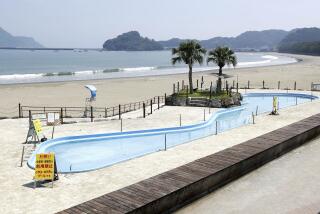9.0 Japan earthquake shifted Earth on its axis
Fridayâs earthquake off the eastern coast of Japan was upgraded to a magnitude 9.0 by the Japan Meteorological Agency, the Kyodo News agency reported Sunday.
The agencyâs scientists probably had access to new data, said U.S. Geological Survey seismologist Susan Hough. âIf theyâve upgraded, I expect USGS might follow suit,â she said, adding that it was not unusual for magnitudes to move up or down by 0.1, because large earthquakes can be tricky to measure.
âItâs not surgical precision,â she said.
Other details are emerging. The quake probably shifted the position of Earthâs axis about 6.5 inches, said Richard Gross, a geophysicist at the Jet Propulsion Laboratory in La Canada Flintridge, in an e-mail.
The temblor also should have caused Earth to rotate somewhat faster, shortening the length of the day by about 1.8 microseconds, he said.
Down the road, data from the quake will provide an unusually precise view of how Earth is deformed during massive earthquakes at sites where one plate is sliding under another, including the U.S. Pacific Northwest, scientists said.
Interactive map: Track hundreds of temblors before and after the great quake
The rich detail comes from an extensive network of sensors placed at sites across Japan after that countryâs Kobe earthquake of 1995, a magnitude 6.8 quake that killed more than 6,000.
âThe Japanese have the best seismic information in the world,â said Lucy Jones, chief scientist for the Multi-Hazards project at the U.S. Geological Survey, at a Saturday news conference at Caltech in Pasadena. âThis is overwhelmingly the best-recorded great earthquake ever.â
Already, just over 36 hours after the quake, data-crunchers had determined that the temblorâs force moved parts of eastern Japan as much as 12 feet closer to North America, scientists said, and that Japan has shifted downward about two feet.
Jones said that USGS had determined that the entire earthquake sequence -- including associated foreshocks and aftershocks -- had so far included 200 temblors of magnitude 5 or larger, 20 of which occurred before the big quake hit. She said the aftershocks were continuing at a rapid pace and decreasing in frequency although not in magnitude, all of which is to be expected.
Researchers have many items they hope to study.
Caltech seismological engineer Tom Heaton said the tragedy would provide unprecedented data on how buildings hold up under long periods of shaking.
âWe had very little information about that before now,â he said. Though precise numbers are not yet available, he predicted that the data would show that buildings in Japan shook for a full three minutes.
Many of the lessons will apply to other parts of the world than California, because the stateâs fault topography is different from that involved in the Japanese quake. The data are relevant, however, to the Pacific Northwest, where the Cascadia Subduction Zone extends 600 miles south from British Columbia.
Geological evidence as well as historical records of tsunami deaths in Japan -- from giant waves believed, based on modern analysis, to have come from a Cascadia quake -- suggest that the most recent large earthquake in the Pacific Northwest occurred in 1700.
Another massive quake in the Pacific Northwest is âinevitable,â the USGSâs Jones said, though it may not occur for hundreds of years.
âThey have an opportunity,â she said. âThis will help the Pacific Northwest understand what they should be ready for. I wouldnât be sleepless in Seattle, but Iâd be studious.â







